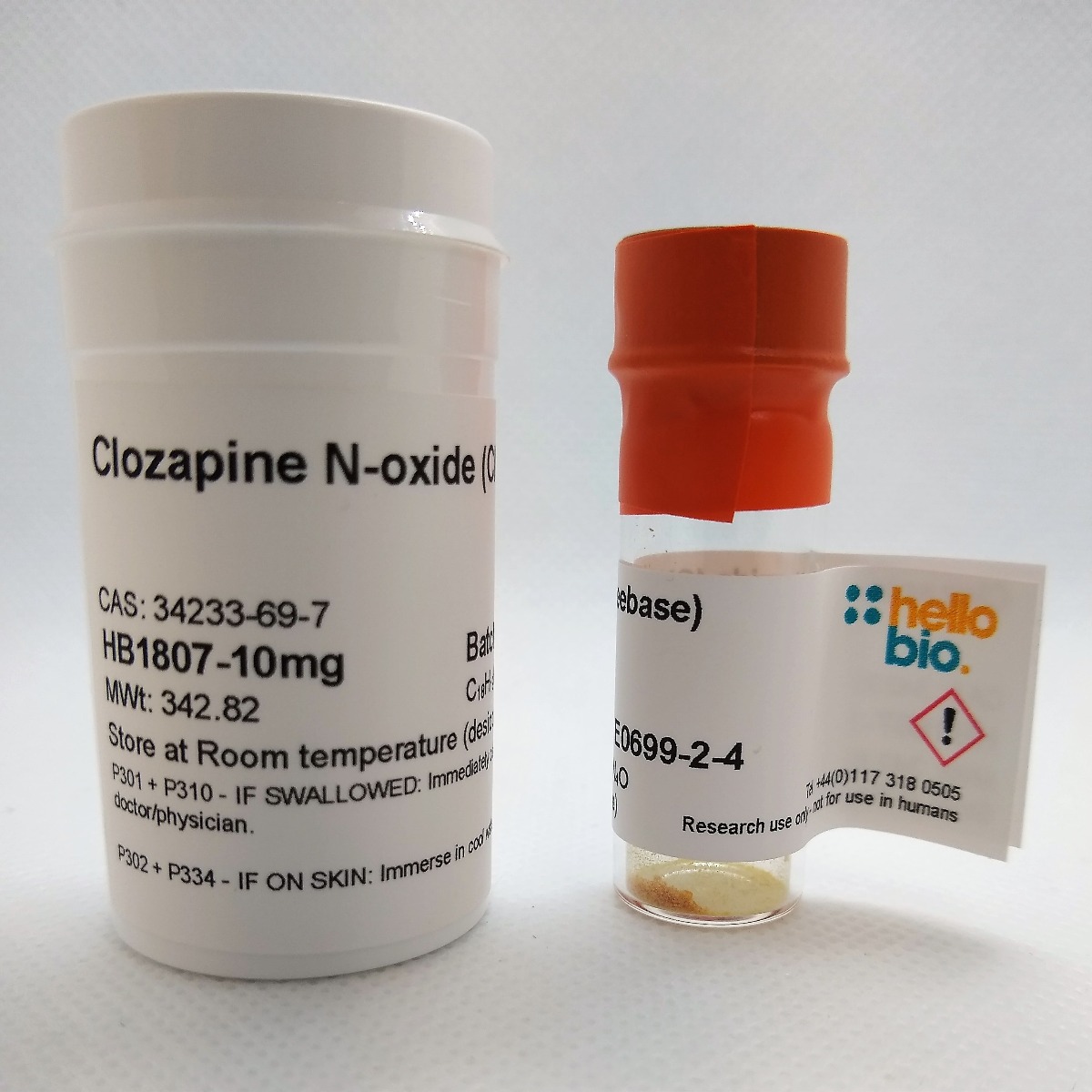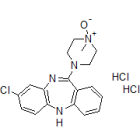Clozapine N-oxide (CNO) (freebase)
Product overview
| Name | Clozapine N-oxide (CNO) (freebase) |
| Alternative names | CNO, CNO freebase |
| Purity | >98% |
| Customer comments | Your technical review on CNO stability, solubility and use in the lab has been really helpful to my group. Verified customer Exactly as described - Clozapine N-oxide (CNO) (freebase) does exactly what it should. Great product and company. Verified customer, Istituto Italiano di Tecnologia |
| Description | Prototypical DREADD activator. Clozapine metabolite. |
Images
Biological Data
| Biological description | Overview Clozapine N-oxide CNO) is the prototypical chemical actuator for various DREADDs. It is a metabolite of the atypical antipsychotic clozapine.
CNO activates the excitatory Gq- coupled DREADDs: hM3Dq, hM1Dq and hM5Dq (pEC50 values are 7.26 and 8.61 at hM3Dq and hM1Dq respectively). The hM3Dq DREADD is typically used for enhancing neuronal firing and activity (Gq- signaling in neuronal and non-neuronal cells). ‘Inhibitory’ (Gi- coupled) DREADDs: CNO also activates the inhibitory hM4Di and hM2Di Gi-coupled DREADDs (pEC50 = 6.89 at hM4Di). The hM4Di DREADD is the most commonly used inhibitory DREADD and is used for neuronal silencing. Gs and β-arrestin coupled DREADDs: CNO also activates the Gs- coupled DREADD (GsD) and the β-arrestin preferring DREADD: rM3Darr (Rq(R165L).
Care must therefore be taken in experimental design and proper controls should be incorporated, for example, the use of non-DREADD expressing animals may be appropriate (see Mahler and Aston-Jones (2018)).
Clozapine N-oxide (CNO) dihydrochloride is water soluble and easier to solubilise and handle. Our stability studies have found that this product does not precipitate in aqueous solution unlike the freebase form of CNO (which due to its inherent chemical properties requires careful handling, has been shown in the literature to precipitate in solution under certain conditions and batch to batch variation in solubility can occur).
|
Solubility & Handling
| Solubility overview | Soluble in DMSO (100mM). |
| Storage instructions | Room temperature (desiccate) |
| Handling | Due to the inherent chemical properties of CNO, this product requires careful handling – our guidelines are detailed below. Batch to batch variation in solubility can occur. Some batches are water soluble but ongoing solubility in aqueous solutions can be unpredictable. CNO has been shown in the literature to precipitate in aqueous solution and following further solubility studies that we have undertaken, we have found that precipitation occurred in some concentrated (100mM) samples of CNO dissolved in water. We therefore recommend using DMSO when working with CNO freebase. If you need to work with aqueous solutions, you should use CNO dihydrochloride which is easier to solubilize and handle than CNO freebase. Our stability studies have found that this product does not precipitate in solution.
CNO (freebase) is soluble in DMSO to 100 mM. Storage of solutions in DMSO
Solubilizing CNO (freebase) in aqueous solutions (e.g. water / saline) We do not recommend using CNO freebase with aqueous solutions however, we provide these guidelines if you do: When working with the compound in aqueous solutions, we recommend:
Stability Our stability studies have shown that CNO in solution remains chemically stable (>99% purity by HPLC) for at least 4 weeks at room temperature. Storage of solutions in aqueous solutions (e.g. water/saline We recommend that you do not store aqueous solutions of CNO. However, if this is necessary:
Precipitation If you find precipitate in your solution, gently heat your solution in a water bath to approx 40°C and the compound should readily re-dissolve. Always take care to ensure that the compound is completely dissolved before use.
CNO dihydrochloride is now available and is also water soluble. It is easier to solubilise and handle and unlike the freebase form of CNO, our stability studies have found that this product does not precipitate in solution.
|
| Shipping Conditions | Stable for ambient temperature shipping. Follow storage instructions on receipt. |
| Important | This product is for RESEARCH USE ONLY and is not intended for therapeutic or diagnostic use. Not for human or veterinary use. |
Chemical Data
| Purity | >98% |
| Chemical name | 8-Chloro-11-(4-methyl-4-oxido-1-pip erazinyl)-5H-dibenzo[b,e][1,4]diazepine |
| Molecular Weight | 342.82 |
| Chemical structure | ![Clozapine N-oxide | [34233-69-7] Clozapine N-oxide | [34233-69-7] Chemical Structure](https://cdn.hellobio.com/media/catalog/product//h/b/hb1807_2.png) |
| Molecular Formula | C18H19ClN4O |
| CAS Number | 34233-69-7 |
| PubChem identifier | 2819 |
| SMILES | C[N+]1(CCN(CC1)C2=C3C=CC=CC3=NC4=C(N2)C=C(C=C4)Cl)[O-] |
| Source | Synthetic |
| InChi | InChI=1S/C18H19ClN4O/c1-23(24)10-8-22(9-11-23)18-14-4-2-3-5-15(14)20-16-7-6-13(19)12-17(16)21-18/h2-7,12,21H,8-11H2,1H3 |
| InChiKey | WYRDWWAASBTJLM-UHFFFAOYSA-N |
| MDL number | MFCD00210190 |
| Appearance | Yellow solid |
References for Clozapine N-oxide (CNO) (freebase)
-
The role of M1 muscarinic receptor agonism of N-desmethylclozapine in the unique clinical effects of clozapine.
Weiner et al (2004) Psychopharmacology (Berl). 177(1-2) : 207-16
-
Central and peripheral GLP-1 systems independently suppress eating
Brierley DI et al (2021) Nat Metab 3(2) : 258-273PubMedID: 33589843 -
Resting-state dopaminergic cell firing in the ventral tegmental area negatively regulates affiliative social interactions in a developmental animal model of schizophrenia
Sotoyama H et al (2021) Transl Psychiatry 11(1) : 236PubMedID: 33888687 -
Resting-state dopaminergic cell firing in the ventral tegmental area negatively regulates affiliative social interactions in a developmental animal model of schizophrenia
Sotoyama H et al (2021) Transl Psychiatry 11(1) : 236PubMedID: 33888687 -
Somatostatin neurons control an alcohol binge drinking prelimbic microcircuit in mice
Dao NC et al (2021) Neuropsychopharmacology 46(11) : 1906-1917PubMedID: 34112959 -
Circadian neurons in the paraventricular nucleus entrain and sustain daily rhythms in glucocorticoids
Jones JR et al (2021) Nat Commun 12(1) : 5763PubMedID: 34599158







 Understanding purity and quality - a guide for life scientists
Understanding purity and quality - a guide for life scientists

